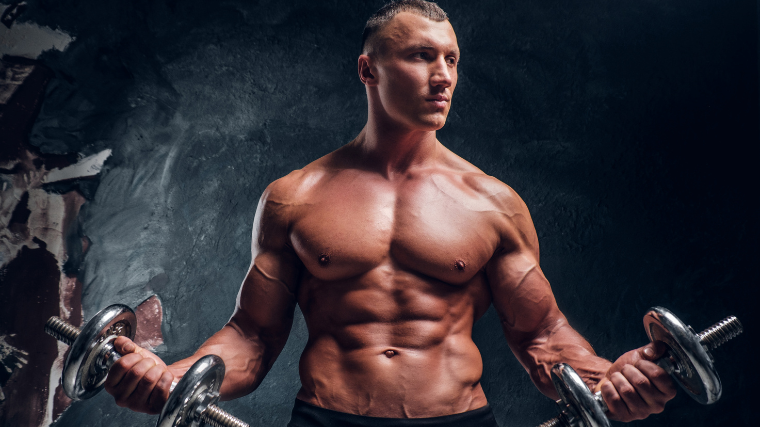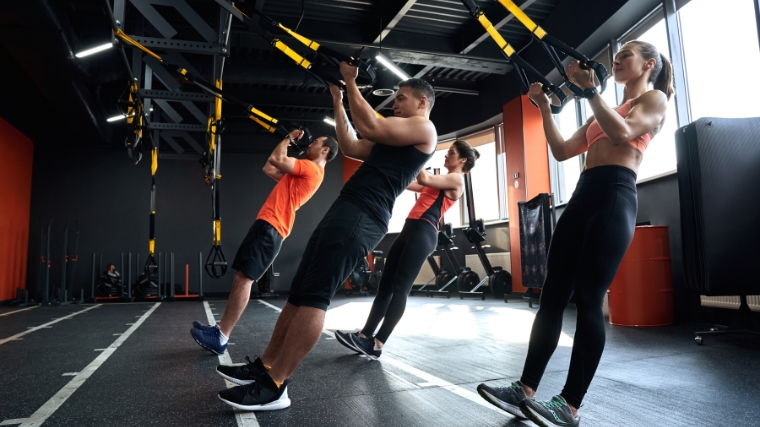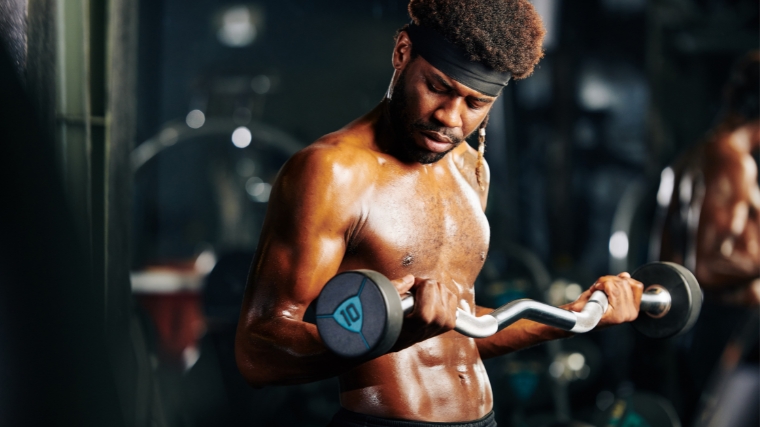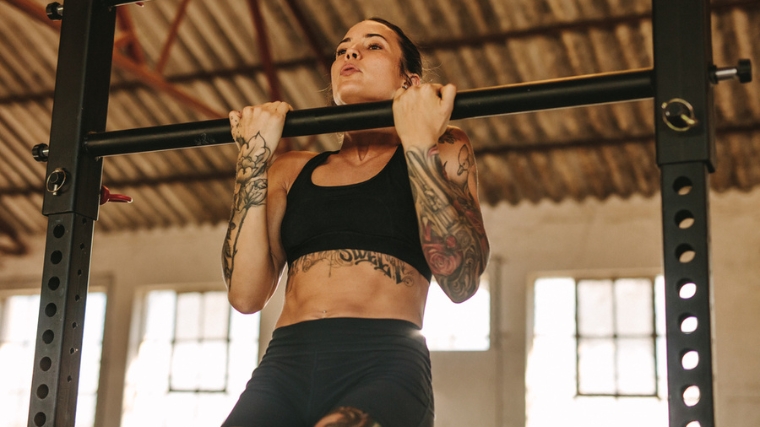Take a trip to the gym and gaze in the mirror. The biceps are one of the muscles people will likely be staring at the most. All manner of posing revolves around the sleeve-expanding potential of the upper arms.
The more you know about your biceps, the better equipped you are to build them out. This muscle has two heads — the biceps long head and the biceps short head. While both heads of the biceps are important, focusing on the short head, AKA your inner biceps, can create a more pronounced and aesthetically pleasing rounded look.

While you can’t completely isolate the short head, you can perform certain exercises — think: curls — that will emphasize and activate the inner biceps muscle. Here are five of the best short-head biceps exercises and some helpful training tools to create a well-rounded arm workout.
Best Short-Head Biceps Exercises
Reverse-Grip Inverted Row
If you’ve been in the gym and seen someone hanging horizontally from the bar on a Smith machine, you’ve likely witnessed some serious biceps strength in the making. Inverted rows aren’t just a tremendous back-builder — they also pack a powerful punch to the biceps.
By using a reverse grip, you’ll be biasing your biceps even more. Just make sure you’re pulling up to the top of your range of motion with every rep. You don’t want to leave any potential muscle growth on the floor.
[Read More: How to Do the Concentration Curl for Bigger Biceps]
Inverted rows will build your lats and improve your pulling strength with just your body weight. You can easily scale this movement by adjusting your foot placement and the bar height. Also, the inverted row is a beginner-friendly move that can help you strengthen your back and biceps for your first pull-up or chin-up.
How to Do the Reverse-Grip Inverted Row
- Place a barbell in a squat rack or use the bar from a Smith machine. Secure the bar high enough for you to be able to hang below it with straight arms.
- Grip the bar with an underhand grip about shoulder-width apart. Scoot underneath the bar, walking your feet forward until you’re hanging underneath it.
- Drive your elbows back and down toward your back pockets, pulling until your chest touches the bar or you hit your upper range of motion.
- Lower yourself down to the starting position. Maintain control and keep your core stable.
Coach’s Tip: The more horizontal you are and the straighter your legs, the harder this move will be. To make it easier, plant your feet on the ground with bent knees or raise the bar so you’re less horizontal during your pull.
Sets and Reps: Perform two to four sets to one or two reps shy of failure.
TRX Suspension Curl
Using TRX suspension ropes can be a tremendous help in learning how to control your body in space. The more kinesthetic awareness you have, the better you’ll be able to perform under a loaded barbell. And when it comes to training your inner biceps, there’s almost nothing like the TRX suspension curl.
This biceps curl variation not only works your target muscle. It also forces you to stabilize through your core, improve your balance, and increase strength overall. Yet again, you won’t even need any weights to perform this move, making it very accessible to athletes working from a home gym.
You only need your body weight to do this exercise, making it very accessible for folks working out of their home gym. The TRX suspension curl is very easy to scale; shift your legs to make your body more or less horizontal with the ground. You’ll also challenge your core because you’ll need to maintain a plank during a dynamic upper-body exercise.
How to Do the TRX Suspension Curl
- Secure the suspension ropes to a stable anchor point above your head. Grab onto one handle with each hand.
- Step toward the anchor point, letting your arms extend outward. Your body will be angled away from the TRX, with your feet out ahead of where your upper body is. Rotate your hands so that your palms are facing up.
- Curl your body weight up by squeezing the bottom of your biceps together with the top of your forearm.
- Slowly extend your arms until you reach the starting position again.
Coach’s Tip: Keep your body in a plank during your entire set. Aim to keep your hips in line with your shoulders and feet.
Sets and Reps: Do two to four sets to near failure.
Spider Curl
You don’t need to be a fan of arachnids to get strong with this one. The name doesn’t refer to the creature, but rather to the position you’ll assume during the exercise. It’ll be a bit like a preacher curl but with your entire chest supported by an incline weight bench.
Having support for your chest will provide external stability that ensures you’ll be focusing on nothing other than the weight. Avoid jerking upward with your lower back, instead bearing down on your chest and belly to send all the emphasis to your inner biceps.
[Read More: Do the Incline Dumbbell Curl to Double Down on Your Arm Gains]
Because you’ll have the external support of the weight bench, all you’ll need to worry about is moving the weight. The spider curl allows your arms to come to full extension at the bottom of your reps, which maximizes your range of motion. You can do this move with dumbbells or an EZ bar to make it customizable.
How to Do the Spider Curl
- Set up an adjustable bench on an incline. Lie on it face down.
- Reach down to grab an EZ bar or dumbbells, or have a spotter pass them to you. Curl the weights toward the bottom of the bench.
- Squeeze your biceps at the top of your contraction. Take your time lowering the weight on the eccentric portion of the lift.
Coach’s Tip: This might be a tricky one to get into position for if you don’t have someone to pass you the weights. It’s okay if you need to shimmy a little awkwardly to get the job done.
Sets and Reps: Perform two to four sets of eight to 15 reps.
Zottman Curl
If you’re in the business of building bigger biceps, you may well be seeking bigger forearms, as well. At the very least, you probably want to make sure they’re both as strong as can be to support your bigger lifts. Fortunately, the Zottman curl can help you in all those respects.
Since you’ll be rotating the dumbbell mid-rep, your biceps will be hit from all angles during this move. Your inner biceps will feel the pump, especially when you focus on squeezing your biceps at the top as you rotate your palms.
This move improves grip strength and helps work your entire arm. The Zottman curl activates your forearms, priming you for growth. You’ll emphasize your inner biceps with this exercise as you move through different arm angles with each rep.
How to Do the Zottman Curl
- Hold a dumbbell in each hand with your palms facing up.
- Slowly curl the weights toward you, contracting your muscles as hard as possible.
- Rotate your hands at the top of your contraction so that your palms are facing down.
- Slowly lower the weight.
Coach’s Tip: Most biceps curl variations will have you squeezing at the top — but during the Zottman curl, you’ll be squeezing and rotating your palms at the same time. Don’t neglect this, because it’s what will truly light up your biceps short head.
Sets and Reps: Perform three to four sets of six to eight reps.
High Pulley Cable Curl
This movement may be one of the hardest short-head biceps exercises to do correctly. For this reason, the high pulley cable curl is best for advanced lifters.
You’ll need to maintain a high level of strength and stability through your core and shoulders, all while paying a lot of attention to your biceps themselves. Your shoulders might get tired before your biceps do. Fight to maintain good form throughout.
[Read More: Best Power Racks]
Using the cable machine creates accommodating resistance, meaning that you’ll spend more time under high-quality tension. The positioning of the high pulley cable curl works the core and other stabilizer muscles. Your inner biceps will feel the pump.
How to Do the High Pulley Cable Curl
- Stand in the middle of the cable machine and bring the pulleys on both sides to shoulder height. Attach D-handles to each side. Choose your desired resistance.
- Grab a handle in each hand. Stand tall. Avoid leaning backward, forward, or to one side or the other.
- Curl both hands towards the sides of your head until your hands are stacked above your shoulders
- Hold the fully contracted position and squeeze. Return slowly back to the starting position.
Coach’s Tip: If you can’t keep your upper arms parallel to the floor while maintaining a strong contraction, you might want to lower the weight.
Sets and Reps: Perform three to four sets of 12 to 15 reps.
Short Head Biceps Warm-Up
Regularly stretching your biceps can help improve flexibility and performance while potentially speeding up recovery.
[Read More: Active Stretches for Optimal Recovery & Performance]
In this warm-up, you’ll do some static stretches first to get you connected with these muscles. You can also easily integrate these moves into daily mobility workouts.
- Standing Biceps Stretch: 30 seconds per side
- Wall Corner Stretch: 30 seconds per side
- Behind-the-Back Biceps Stretch: 30 seconds per side
- Forearm Rock: 30 seconds
- Resistance Band Curl: 15-25 reps
If you’re going particularly heavy with a particular exercise, make sure you also perform ramp-up sets. Don’t jump immediately into the big weights. Instead, let your muscles, tendons, and joints acclimate to the strain gradually for best results.
How to Train Your Biceps Short Head
Yes, you probably get a lot of training stimulus to your biceps from your regularly-scheduled exercises. Deadlifts, pull-ups, and row variations all contribute to biceps strength and growth. But if you want to get specific with your biceps short head, here’s how.
Short Head Biceps Exercise Selection
Choosing exercises is something you always want to do strategically. Consider how much work your biceps are getting in the rest of your program and what your goals are. If you’re getting plenty of biceps stimulation from your main program and just want to get them a little extra strength, you may not need to add many exercises.

[Read More: Everything You Need to Know to Build Your First Workout Program]
But if you’re looking to build a lot more muscle, emphasize both isolation and compound exercises that focus on your inner biceps. Consider adding them to a part of your workout where you’re still fresh instead of holding them until last so that you can focus on them fully.
Short Head Biceps Sets and Reps
Ultimately, training the short head of your biceps is about training… well, your biceps. But for the exercises emphasized here, there are particular set and rep strategies you might want to use to maximize your growth potential.
- For Strength: Aim for three sets of eight to 10 reps with relatively heavy weight. Your biceps is not a large muscle, so you’re not going to dive into lower rep ranges like you would with bigger compound exercises.
- For Muscle Growth: To stimulate hypertrophy, use moderately heavy weights and perform three to four sets of eight to 12 reps. Aim to perform reps to failure.
- For Endurance: Use challenging but light weight and focus on peak muscle contraction. Perform two to three sets of 15 to 20 reps.
If you want to increase the intensity, consider using drop sets to get yourself the pump you’re searching for. This method is especially popular when training your biceps. This style of training allows you to fatigue the muscle greatly.
Here’s how to do it: start by using a weight where you’ll hit failure at 10 to 12 reps. Drop down a few pounds and go to failure again; repeat until you reach a weight that is either too light to be difficult or you can’t continue further.
Short Head Biceps Training Tips
Before you start training your biceps, remember that slow and steady means extra time under tension. And time under tension can yield much more growth. Biceps training should be focused on the intense and intentional contraction of the muscle for the most gains. Actively focusing on squeezing the muscle as you perform will create more hypertrophy and your desired result.
Focus on Form
Your mind-muscle connection is often considered to be of primary importance when training for hypertrophy. Especially with smaller muscles like the biceps, you’ll want to pay attention to form above all else.

Consider using a wall or bench for support during your biceps training to make sure you’re in the proper position. This added stability may help you avoid using momentum unintentionally. On the other hand, you can use momentum strategically toward the end of your sets to help you eke out a few reps before failure.
Diversify Your Equipment
The great thing about the best biceps exercises is the various equipment you can use to target the same muscle in different ways. Utilize TRX suspension ropes, EZ bars, barbells, dumbbells, cable machines, and pull-up bars to focus on the inner biceps.
[Read More: Learn the Best TRX Exercises for Your Experience Level]
Using different equipment means you can come at your workout — and your muscles — from different angles. By taking advantage of different training implements, you’ll also be keeping your workouts from getting mentally stale. Since focusing on your mind-muscle connection is so important with isolation exercises like these, you’ll need to be very mentally present.
Don’t Neglect Your Compound Lifts
Compound exercises involve your larger muscles and extend across multiple joints. When you’re searching for compound lifts that will emphasize your biceps, think chin-ups and inverted rows. Program these bigger lifts earlier in your workout so you can attack them with the most energy.

Alternatively, if you want to pre-exhaust your muscles, you can do your compound exercises last. That way, your muscles will already be fatigued so you can push yourself to failure even more.
Anatomy of the Biceps
Technically known as the biceps brachii, your biceps has two “heads” — one long, and one short. They’re the same muscle, but because they have slightly different locations, you may notice them in different ways.
Biceps Short Head
At the end of the day, the short head and long head of your biceps really aren’t all that different. But the short head sits on the inside of your arm — hence, forming your “inner” biceps. This is that nice peak you might notice when flexing directly in the mirror.
Biceps Long Head
On the other hand, the long head of your biceps is located more toward the outside of your arm. If you’re posing with a camera facing your back, that’s the part of the biceps that will be more prominent.
More Training Content
Now that you’ve got the best short-head biceps exercises under your belt, it might be time to expand your sleeve-busting repertoire. With consistency and dedication, you’ll see the results you’re looking for in no time.
Here are some other muscle groups you might want to grow next.
- The Best Triceps Exercises and Workouts
- The Best Forearm Exercises and Workouts
- The Best Shoulder Exercises and Workouts
Featured Image: FXQuadro / Shutterstock